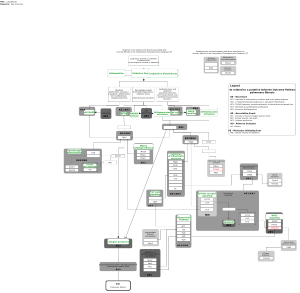User:Marvin M2/AOPportal
From WikiPathways
The Adverse Outcome Pathway (AOP) Portal on WikiPathways
Welcome to the Adverse Outcome Pathway Portal!
This Adverse Outcome Pathway (AOP) portal for WikiPathways is created to highlight the molecular basis of AOPs or events in AOPS. In general, AOPs start with a Molecular Initiating Event (MIE) caused by a stressor, followed by Key Events (KEs), that lead to an Adverse Outcome (AO). These AOPs are intended specifically for regulatory decision making and are typically stored in the AOP Knowledge Base (AOPKB). Because AOPs are simplified explanations of biological effects after the effect of a stressor they are not useful to describe and understand the molecular basis of the AOPs and not suited to do data analysis. Such analysis is needed especially for in silico risk analysis that is intended to lower animal use in toxicology studies. This portal was created to present the molecular level of the AOPs and getting more into detail on the biological processes involved in them. The development of these molecular AOPS is relevant for the European research projects on toxicology EU-ToxRisk and OpenRiskNet that also fundedn part of the work.
News
2017-03-29 - The first AOPs that are added into this portal on pulmonary fibrosis, are results of the eNanoMapper project.
2017-03-29 - This portal was created
Mission
The purpose of this portal is to create a collection of AOPs on the molecular level for the AOPs that are, or will be created for the EU-ToxRisk program, in which Open PHACTS Foundation (OPF) is responsible for AOP creation. The subjects of the first AOPs are linked to the use cases of the EU-ToxRisk program, and there will be a team of experts involved in the creation of each AOP.
The proposed list of the first set of AOPs to be created:
- Inhibition of β-oxidation leads to liver steatosis
- HDAC inhibition, folate antagonism, oxidative stress and foetus accumulation lead to teratogenicity
- Oxidative stress leads to hepatotoxicity
- Oxidative stress leads to nephrotoxicity
- Disturbance of the respiratory chain leads to mitotoxicity
- PPAR activation leads to hepatoxicity
- OAT overactivation leads to nephrotoxicity
- PXR activation leads to liver steatosis
- NAPQI production causes hepatotoxicity
- MTP impairment leads to hepatotoxicity
- CYP51 inhibition causes embryotoxicity
- Epithelial damage leads to popcorn lung
Basic strategies and principles for general AOPs are described in this paper:
Villeneuve et al. (2014). Adverse Outcome Pathway (AOP) Development I: Strategies and Principles. Toxicological Sciences PubMed
Support
The EU-ToxRisk and OpenRiskNet projects are funded by the EU, CORDIS Project IDs 681002 and 731075 respectively.







